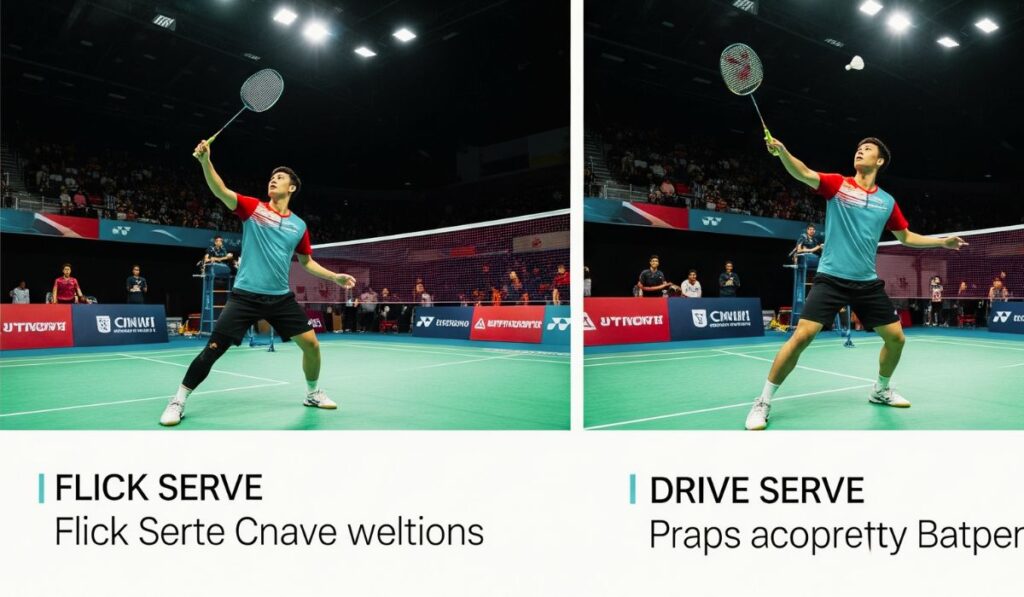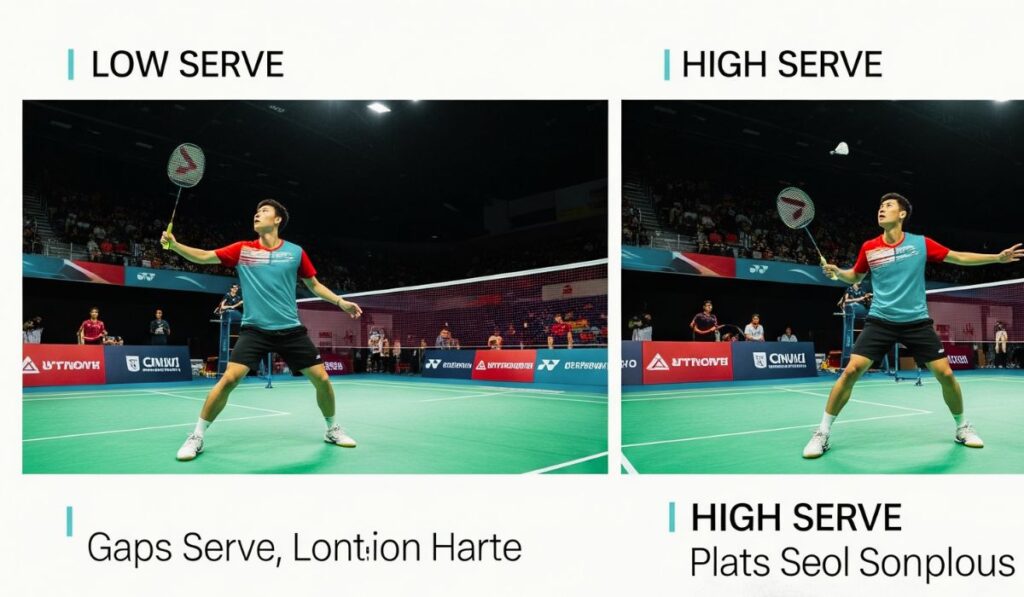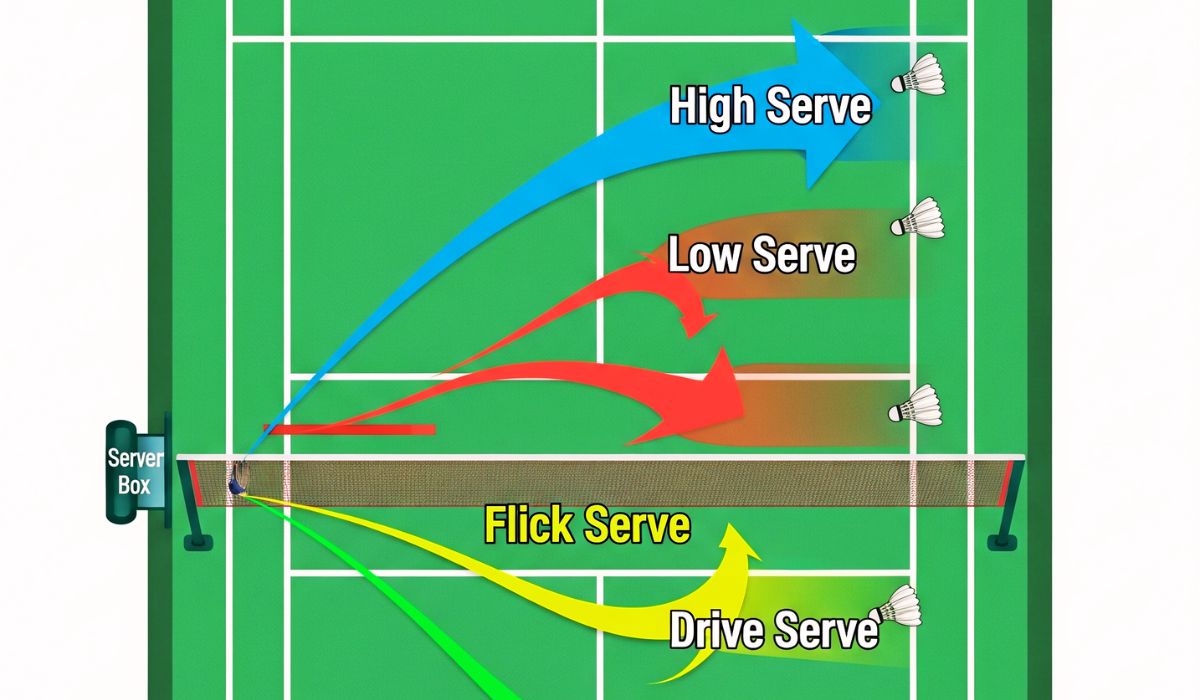“The Shocking Truth About Badminton Serves: 4 Powerful Techniques That Could Make or Break Your Game”
4 types of serve in badminton is not just the first shot of a rally—it’s the heartbeat of the game, the moment that sets everything in motion. The way a shuttle leaves your racket can either empower you with control or hand over the advantage to your opponent without a fight. A serve might look simple to an outsider, but for a player who truly understands the sport, it’s a moment of pure strategy, technique, and emotional focus.
In this guide, we will explore the 4 types of serve in badminton—each with its unique feel, rhythm, and tactical use. We will not only talk about the technical aspects but also bring you into the sensory world of badminton, where you can almost feel the tension in your fingers before that first flick, smell the faint scent of polished wooden floors, and hear the shuttle slicing through the air.
The High Serve – Painting the Sky with Your Shuttle
The high serve is like an artist’s brushstroke—graceful, deliberate, and full of intention. You raise your arm, feeling the smooth grip of the racket against your palm, and with a controlled swing, send the shuttle soaring high into the opponent’s court. It climbs in a majestic arc, almost touching the rafters, before plummeting down like a falcon diving for its prey.
The high serve is often used in singles play to push your opponent to the back of the court, forcing them into a defensive position. The magic lies not in brute force but in precision. Too short, and you invite a smash. Too long, and you lose the point. Perfectly executed, it gives you time to reset your stance, read your opponent’s movement, and prepare for the rally ahead.
When you hit a flawless high serve, there’s an almost electric satisfaction—the kind that makes your pulse quicken, your chest expand, and your confidence surge. It’s not just a serve; it’s a statement of 4 types of serve in badminton.
The Low Serve – Whispering Danger Across the Net
The low serve is subtle, understated, yet dangerously effective—like a quiet whisper in a crowded room that still draws every ear. You hold the shuttle just below your waist, your racket barely lifting, and with a gentle push, you send it skimming just over the tape.
The thrill of a perfect low serve comes from its razor-thin margin for error. The shuttle should pass the net so close you could almost imagine it brushing the cord. Too high, and your opponent pounces with an attacking shot. Too low, and the net swallows your effort.
In doubles, the low serve is a weapon of choice. It limits the opponent’s ability to attack and forces them into a controlled, predictable return. Executing it well requires a stillness of mind, steady hands, and an awareness of your own breathing—the kind of calm control that can unnerve even the most aggressive player.

The Flick Serve – Deception in Motion
The flick serve is pure theater—a sly grin hidden behind an innocent face. You begin as if preparing for a low serve, lulling your opponent into anticipation. Then, in a split-second, your wrist snaps, sending the shuttle arcing just beyond their reach at the back of the court.
This serve thrives on surprise. It is a test of timing, disguise, and nerve. Pulling off a perfect flick serve feels like delivering the punchline to a joke only you knew was coming. The opponent scrambles backward, their body twisting mid-step, as the shuttle glides beyond their comfort zone.
The flick serve is not about power—it’s about trickery. It demands that you read your opponent’s stance, notice their weight distribution, and sense the tiny cues that betray their expectations. The sound of the shuttle leaving the racket is almost sharper, more urgent, carrying with it the rush of having outwitted your rival.
The Drive Serve – Speed That Cuts Like a Blade
The drive serve is not for the faint of heart—it’s fast, flat, and aggressive, like a blade slicing through the air. You stand ready, your racket poised, and in one swift motion, send the shuttle screaming horizontally across the court, forcing your opponent into instant reaction.
The beauty of the drive serve lies in its speed. It leaves little room for your opponent to prepare, often catching them off balance. But it is also risky; a misjudged angle or too much force, and the shuttle sails out. The drive serve requires courage and commitment—you cannot hesitate, or the serve loses its sting.
When executed with precision, it delivers a rush like no other. The shuttle zips across the net, your opponent’s eyes widen, and for a fleeting moment, the momentum is entirely yours.
The Sensory World of Serving 4 types of serve in badminton
Every type of serve in badminton carries its own sensory story. The soft hum of the shuttle feathers as they cut through the air. The way your racket’s strings respond, taut yet forgiving, under the strike. The faint echo of a foot shifting on the court. These aren’t just technical details—they are the intimate moments that make serving in badminton a deeply personal art.
Serving is not just about starting the game—it’s about seizing psychological control. It’s about making your opponent feel a half-step too slow, a fraction too late, or a little too uncertain. When you master all four serves, you don’t just play the game—you dictate its rhythm.
The 4 types of serve in badminton as the Heartbeat of Every Rally
The serve in badminton is more than just the opening stroke — it is the heartbeat that sets the tempo for the rally. Imagine the way your fingers brush against the cork, the smooth shaft of the racket trembling ever so slightly in your hand. The air feels heavier for a moment, the court silent, every eye fixed on you. The shuttle rests weightless, yet filled with the potential to change the outcome of a match. That first serve can carry an electric thrill or a cold dread, and the difference lies in how you execute it.
Understanding the 4 types of serve in badminton
When it comes to mastering badminton, the four serves — high serve, low serve, flick serve, and drive serve — are the elemental strokes you must know. Each one has its own personality, its own flavor. The high serve soars like a bird carried by the wind, daring your opponent to chase it down. The low serve is like a whisper — subtle, calculated, and almost invisible until it’s too late. The flick serve carries the element of surprise, catching the receiver off balance. And the 4 types of serve in badminton is a weapon of force, a strike of speed and aggression meant to take your opponent’s breath away.
The High Serve: Majesty in Motion
The high serve is poetry in the air. As you strike the shuttle, it climbs gracefully, reaching its peak before falling deep into the opponent’s court. There is a rhythm in its arc, a promise in its descent. When done right, it buys you time, positioning you for a strong defense while forcing your opponent to take a risk. Every high serve feels like sending a kite into the sky, only to pull it back with precision.
The Low Serve: The Whisper That Wins
The low serve, in contrast, doesn’t aim for grandeur — it aims for control. It barely clears the net, skimming over like a feather in the breeze. The beauty of the low serve lies in its subtlety. Your opponent leans forward, expecting to pounce, but the shuttle falls just short, making them stretch, making them misstep. This serve is not about power; 4 types of serve in badminton it’s about making your opponent dance to your tune.
The Flick Serve: The Art of Deception
The flick serve is a magician’s trick in badminton. Everything in your body language screams “low serve,” but at the last second, your wrist snaps, sending the shuttle arching high and fast over your opponent’s head. The thrill comes in watching them scramble, realizing too late what you’ve done. It’s a 4 types of serve in badminton of mind games, of daring, of calculated risk.
The Drive Serve: Raw Power Unleashed
The drive serve doesn’t tiptoe around strategy — it charges straight in. It’s a flat, fast stroke that forces your opponent into immediate reaction. There’s something almost primal about it: the sharp crack of shuttle on strings, the blur of white against the green court, the rush of adrenaline as you force your opponent onto the defensive from the first shot of 4 types of serve in badminton.
Choosing the Right Serve for the Right Moment
Great players know that no serve exists in isolation. It’s not about memorizing four moves — it’s about knowing when to use them with 4 types of serve in badminton. A high serve can buy you time when you need to reset; a low serve can break the rhythm of a player who thrives on aggression. The flick serve can punish an opponent who stands too close, while the drive serve can overwhelm someone slow to react.
The Psychological Warfare Behind the Serve
4 types of serve in badminton tells a story — and every opponent is reading yours. If you repeat the same serve too many times, they begin to anticipate it. But if you mix them, layering deception into every movement, you make them second-guess. That hesitation, that tiny pause, can be the space you need to take control of the rally.
The Sensory Connection Between Player and Shuttle
When your 4 types of serve in badminton, your senses heighten. You feel the strings tense and release under your fingers, hear the crisp “thwack” of contact, see the shuttle spinning as it cuts through the air. You sense the way your weight shifts on your feet, the court surface firm under your shoes. Serving is as much about feeling as it is about technique.
Training Your Serve to Perfection
4 types of serve in badminton Perfecting the four serves isn’t about luck — it’s about repetition. Hundreds of serves every day, each one deliberate. Feeling the shuttle’s weight. Adjusting the angle of your racket. Listening to the sound of a perfect strike. Training until your muscles remember the movement even when your mind is under pressure.
How a Bad Serve Can Break Your Game
A weak serve can unravel an otherwise brilliant match. Too high on a low serve, and it’s smashed back at you. Too short on a high serve, and your opponent is already charging forward. A predictable flick serve loses its edge; a mistimed drive serve can hand over an easy point. 4 types of serve in badminton is a double-edged sword — it can win you matches or cost you everything.
The Sweet Victory of a Perfect Serve
There’s a special satisfaction when you execute a serve exactly as planned. The shuttle falls exactly where you imagined it would. Your opponent is a step too late. You feel that surge of control, that quiet thrill of knowing 4 types of serve in badminton you set the stage and dictated the pace. It’s one of the purest pleasures in 4 types of serve in badminton.

Serving Under Pressure
In a close game, when the score is tied, the 4 types of serve in badminton becomes a test of your nerve. Your fingers tremble slightly, your breath feels heavier. The temptation to play it safe battles with the urge to take a risk. These are the moments when champions are made — not in the rallies themselves, but in the silent heartbeat before the serve.
Reading Your Opponent’s Positioning
An experienced server watches everything — where the opponent stands, how they hold their racket, the tension in their body. 4 types of serve in badminton From this, you choose your weapon. A player leaning forward invites the flick serve; one standing deep is vulnerable to the low serve. The court is a canvas, and your serve is the first brushstroke.
The Role of Footwork in Serving
Even before you strike, your stance matters. Balanced, steady, ready to move. Your feet anchor you while your upper body delivers the motion. And once you’ve served, your first step sets you up for the next shot. Great servers don’t just think about the 4 types of serve in badminton — they think about the rally that follows.
Why the Serve Is Your First Attack
Many underestimate the 4 types of serve in badminton, thinking it’s simply a way to start the rally. But in reality, it’s your first opportunity to put your opponent under pressure. A well-placed serve limits their options, forcing them into a return that you can anticipate and counter.
Breaking Your Own Patterns
One of the deadliest mistakes is falling into predictability. If you start every game with a high serve, your opponent will adapt. Mixing your serves keeps them on edge, unsure of what’s coming. The uncertainty you create is as valuable as the 4 types of serve in badminton itself.
Serving as an Extension of Personality
The way 4 types of serve in badminton says something about you as a player. Aggressive players favor the drive serve; patient tacticians lean into the low serve. The flick serve suits the mischievous, the high serve suits the composed. In a way, the serve is your handshake — your introduction to the rally.


3 thoughts on “4 types of serve in badminton”